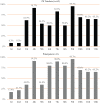Physical education teachers' and principals' perspectives on the use of FitnessGram
- PMID: 30800302
- PMCID: PMC6379791
- DOI: 10.1177/2050312119831515
Physical education teachers' and principals' perspectives on the use of FitnessGram
Abstract
Objectives: FitnessGram is commonly used to measure physical fitness and improve physical activity and health in youth. However, little is known about its use for informing physical activity and health promotion policy within schools and school districts, especially from the perspective of key decision-makers like principals. Therefore, this study examined physical education teachers' and principals' perceptions of FitnessGram use and its relationship with school and district efforts to promote physical activity.
Methods: Principal and physical education teacher surveys were developed, converted to an online format, and then emailed along with a project description and instructions to all Delaware public and charter school physical education teachers (N = 183) and principals (N = 193) with a valid email.
Results: Completed surveys were received from 35.5% of the teachers and 21.2% of the principals. All teachers and 95.1% of the principals reported their school used FitnessGram the past academic year. FitnessGram was significantly more likely to be used if FitnessGram results better aligned with school/district policies (r = 0.39) and were considered important in the school's decision-making process (r = 0.53). Significantly more principals than teachers said that FitnessGram results were important in their school's decision-making process and that FitnessGram results were used to inform policy-/decision-making.
Conclusion: Use of FitnessGram was correlated with how well it related to school/district policy. Unfortunately, most of the physical education teachers and principals did not think FitnessGram was adequately integrated into the policy-/decision-making process.
Keywords: Youth; fitness testing; health-related fitness; policy.
Conflict of interest statement
Declaration of conflicting interests: The author(s) declared no potential conflicts of interest with respect to the research, authorship, and/or publication of this article.
Figures
Similar articles
-
Australian Primary School Principals', Teachers', and Parents' Attitudes and Barriers to Changing School Uniform Policies From Traditional Uniforms to Sports Uniforms.J Phys Act Health. 2020 Sep 3;17(10):1019-1024. doi: 10.1123/jpah.2020-0116. J Phys Act Health. 2020. PMID: 32882680
-
Teachers' and Principals' Familiarity with School Wellness Policy: A Health Promoting Schools Assessment.Int J Environ Res Public Health. 2024 Oct 17;21(10):1372. doi: 10.3390/ijerph21101372. Int J Environ Res Public Health. 2024. PMID: 39457345 Free PMC article.
-
The relationship between principals' pedagogical leadership practices and teachers' job performance: the role of sociodemographic characteristics.BMC Psychol. 2025 Jan 30;13(1):89. doi: 10.1186/s40359-025-02415-7. BMC Psychol. 2025. PMID: 39885574 Free PMC article.
-
Barriers and facilitators to the implementation of physical activity policies in schools: A systematic review.Prev Med. 2018 Feb;107:45-53. doi: 10.1016/j.ypmed.2017.11.012. Epub 2017 Nov 16. Prev Med. 2018. PMID: 29155228
-
What Is Physical Activity? A Holistic Definition for Teachers, Researchers and Policy Makers.Front Sports Act Living. 2020 Jun 18;2:72. doi: 10.3389/fspor.2020.00072. eCollection 2020. Front Sports Act Living. 2020. PMID: 33345063 Free PMC article. Review.
Cited by
-
Attitudes and Values of Physical Education Professionals and Undergraduate Students about Their Role in Health Promotion.Int J Environ Res Public Health. 2020 Mar 28;17(7):2288. doi: 10.3390/ijerph17072288. Int J Environ Res Public Health. 2020. PMID: 32231151 Free PMC article.
-
Comprehensive use of cardiopulmonary exercise testing in pediatrics.Pediatr Endocrinol Diabetes Metab. 2021;27(1):42-46. doi: 10.5114/pedm.2020.103057. Pediatr Endocrinol Diabetes Metab. 2021. PMID: 33599436 Free PMC article. Review.
References
-
- Miller WM, Lilly CL, Elliott E, et al. Teacher perceptions of FitnessGram and application of results. Int J Exerc Sci 2016; 9(2): 187–204.
-
- Morrow JR, Jr, Fulton JE, Brener ND, et al. Prevalence and correlates of physical fitness testing in U.S. Res Q Exerc Sport 2008; 79(2): 141–148. - PubMed
Grants and funding
LinkOut - more resources
Full Text Sources
Miscellaneous


